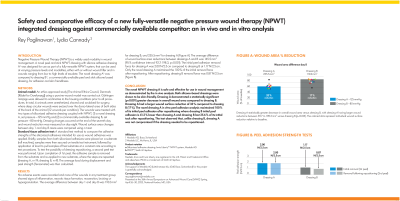Laboratory Research
(LR-039) Safety and comparative efficacy of a new fully-versatile negative pressure wound therapy (NPWT) integrated dressing against commercially available comparators: an in vivo and in vitro analysis
Friday, April 28, 2023
7:15 PM - 8:30 PM East Coast USA Time

Pat Schwab, BS, MBA – Product Marketing Manager Surgical & Wound Care, Healthcare Marketing, Medela LLC
Introduction: Negative Pressure Wound Therapy (NPWT) is a widely used modality in wound management. A new, peel-and-stick NPWT dressing with silicone adhesive,a was designed for use as part of a fully-versatile NPWT system, that can be used at varying pressure levels and modalities, either with or without wound filler and in wounds ranging from low to high levels of exudate. The safety and efficacy of the novel dressing, was compared with commercially available comparators.b,c
Methods: An ethics approved study using a standard porcine wound model was carried out, in triplicate, to compare the effect of the novel dressinga at -80mmHg, -125mmHg and -200mmHg, in comparison with the comparator silicone adhesive dressingb at-80mmHg, in line with its capability. NPWT dressing changes occurred every seventh day. A benchtop peel adhesion study was conducted (n=3) comparing the novel dressing,a with comparator dressings with either siliconeb or acrylic adhesive.c
Results: The novel dressing was safe and effective. No adverse events were recorded and none of the wounds in any treatment group showed signs of inflammation, necrotic tissue formation, maceration, bruising or hypergranulation. The novel dressing was easier to apply compared with the comparator dressing.b After 15-days, wounds treated with the novel dressinga at all pressures tested showed a statistically significant decrease in overall wound area compared to the comparator dressing,b and results showed a trend with increasing levels of negative pressure. The peel adhesion study confirmed that the novel dressing with silicone adhesive required approximately half the force on removal compared with a dressing with acrylic adhesivec (2.00 vs 3.91N/2.5cm). Also, the novel dressing was able to be repositioned with no detriment to its adhesive capability, compared with both other comparator dressingsb,c which had lower adhesion after they had been applied and repositioned.
Discussion: The novel fully-versatile NPWT dressing is safe and effective for use in wound management as demonstrated in an in vivo and in vitro analysis and performed favourably against comparator dressings.
Methods: An ethics approved study using a standard porcine wound model was carried out, in triplicate, to compare the effect of the novel dressinga at -80mmHg, -125mmHg and -200mmHg, in comparison with the comparator silicone adhesive dressingb at-80mmHg, in line with its capability. NPWT dressing changes occurred every seventh day. A benchtop peel adhesion study was conducted (n=3) comparing the novel dressing,a with comparator dressings with either siliconeb or acrylic adhesive.c
Results: The novel dressing was safe and effective. No adverse events were recorded and none of the wounds in any treatment group showed signs of inflammation, necrotic tissue formation, maceration, bruising or hypergranulation. The novel dressing was easier to apply compared with the comparator dressing.b After 15-days, wounds treated with the novel dressinga at all pressures tested showed a statistically significant decrease in overall wound area compared to the comparator dressing,b and results showed a trend with increasing levels of negative pressure. The peel adhesion study confirmed that the novel dressing with silicone adhesive required approximately half the force on removal compared with a dressing with acrylic adhesivec (2.00 vs 3.91N/2.5cm). Also, the novel dressing was able to be repositioned with no detriment to its adhesive capability, compared with both other comparator dressingsb,c which had lower adhesion after they had been applied and repositioned.
Discussion: The novel fully-versatile NPWT dressing is safe and effective for use in wound management as demonstrated in an in vivo and in vitro analysis and performed favourably against comparator dressings.

.png)